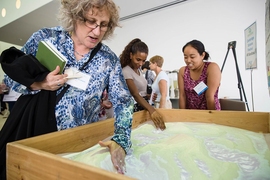No equations allowed. This basic rule drives the thinking behind "Science Out Loud," an original web series hosted and co-written by MIT students. The fun, engaging videos are geared towards middle and high school students and designed to bring scientific concepts to life through research, experiments, and demos performed by real scientists and engineers. No chalkboards. No textbooks. Lots of learning.
The new season of Science Out Loud – now live on YouTube – pushes the boundaries of video production to turn academic education into curiosity-sparking interactive experiences.
There’s a choose-your-own chemistry adventure where viewers can click through the video to change the ingredients of a chemical reaction and create the best foam explosion. Another video explores how virtual reality works, which viewers can watch in 360 degrees on YouTube and Google Cardboard. Yet another showcases MIT’s Scratch programming to make a video game, with the option to watch in English or Italian.
Science Out Loud is part of MIT+K12 Videos, an educational outreach program from the Office of Digital Learning that seeks to encourage a lifelong love of learning through original digital media and live programming. The program aims to promote STEM (science, technology, engineering, and math) literacy while opening the world of MIT to as many people as possible.
“The foundation of MIT+K12 is not video, camera work, or editing,” explains program director Elizabeth Choe. “It’s about what the videos enable. We want to leverage the amazing community of students and people at MIT to challenge people’s notions of what scientists and science look like while sparking curiosity and agency among young people.”
Originally launched by the School of Engineering in 2011, MIT+K12 Videos has produced more than 150 videos that have garnered close to 10 million views on YouTube. The program fits within MIT’s larger pK-12 vision to bring the university’s immersive, hands-on approach beyond the campus and deliver STEM education to pre-kindergarten through grade-12 learners and educators.
For MIT students participating, the program is about developing the skills not just to make a video but to clearly communicate their research and share their passion with a non-STEM audience. All to complement what they’re learning in the classroom.
“K12 Videos gave me such a variety of practical experience,” says K12 Videos Educational Media Fellow and recent graduate Ceri Riley '16. “Every project was different so I got to try out new skills — from producing and editing to animating and filming. It really acted as a springboard for me.” Post-graduation, Riley is already working for SciShow, an extremely popular science channel on YouTube.
“I’m proud of putting myself out there. It challenged me to step outside of my comfort zone, to try new things, and to appreciate the process as much as (or more than) the final product,” says Whitney Hess PhD ’16 and “star” of the choose-your-own chemistry adventure video.
MIT students can get involved with MIT+K12 Videos in a variety of ways, from hands-on hosting and writing to behind-the-scenes education outreach or content consultants to becoming an Educational Media Fellow. For Science Out Loud, students can either directly pitch a video idea or enroll in 20.219 (Becoming the Next Bill Nye) to earn course credit. Volunteers from freshmen to graduate students are always welcome. MIT faculty can also play a role — hosting the #askMIT Q&A series, supporting student-run videos, or collaborating on new projects.
Curiosity sparked? Watch the new season of Science Out Loud or email mitk12videos@mit.edu to get involved. You can also explore materials from previous seasons on PBS Learning Media (includeing teacher supplementary resources), Khan Academy, iTunes U, and Curiosity.com. All videos are freely available and downloadable under a Creative Commons license.









